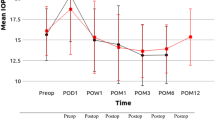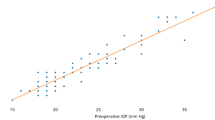The purpose of the study was to determine the independent predictors of long-term intraocular pressure (IOP) reduction after cataract surgery with phacoemulsification. This is a retrospective review of uncomplicated cataract surgeries from 2006 to 2008 at the Baltimore VA Medical Center with longitudinal follow-up. Demographic, clinical, biometric, and intraoperative variables including phacoemulsification parameters were recorded. Univariate and multivariate linear regression were used to analyze the relationship between these variables and postoperative IOP, which was the outcome variable. Analysis was performed in 115 eyes of 115 patients who underwent uncomplicated phacoemulsification during the study period. There was an average postoperative IOP reduction through 12, 24, and 36 months of −1.7 ± 3.1, −1.5 ± 3.8, and −1.3 ± 2.6 mmHg, respectively. Higher preoperative IOP (P < 0.001), a more anterior relative lens position (P < 0.05), and longer phaco time (P < 0.05) were significantly associated with greater postoperative decrease in IOP using univariate analysis. Using multivariate analysis, preoperative IOP (P < 0.001), and phaco time (P = 0.038) were associated with greater postoperative IOP reduction through 24 months. Phaco time is independently associated with IOP reduction after adjusting for age and preoperative IOP. Higher preoperative IOP is associated with a greater IOP-lowering effect after phacoemulsification.

Similar content being viewed by others
References
Shin HC, Subrayan V, Tajunisah I (2010) Changes in anterior chamber depth and intraocular pressure after phacoemulsification in eyes with occludable angles. J Cataract Refract Surg 36:1289–1295. doi:10.1016/j.jcrs.2010.02.024
Pradhan S, Leffler CT, Wilkes M, Mahmood MA (2012) Preoperative iris configuration and intraocular pressure after cataract surgery. J Cataract Refract Surg 38:117–123. doi:10.1016/j.jcrs.2011.07.033
Poley BJ, Lindstrom RL, Samuelson TW (2008) Long-term effects of phacoemulsification with intraocular lens implantation in normotensive and ocular hypertensive eyes. J Cataract Refract Surg 34:735–742. doi:10.1016/j.jcrs.2007.12.045
Poley BJ, Lindstrom RL, Samuelson TW, Schulze R (2009) Intraocular pressure reduction after phacoemulsification with intraocular lens implantation in glaucomatous and nonglaucomatous eyes: evaluation of a causal relationship between the natural lens and open-angle glaucoma. J Cataract Refract Surg 35:1946–1955. doi:10.1016/j.jcrs.2009.05.061
Guan H, Mick A, Porco T, Dolan BJ (2013) Preoperative factors associated with IOP reduction after cataract surgery. Optom Vis Sci 90:179–184. doi:10.1097/OPX.0b013e31827ce224
Suzuki R, Kuroki S, Fujiwara N (1997) Ten-year follow-up of intraocular pressure after phacoemulsification and aspiration with intraocular lens implantation performed by the same surgeon. Ophthalmologica 211:79–83
Jahn CE (1997) Reduced intraocular pressure after phacoemulsification and posterior chamber intraocular lens implantation. J Cataract Refract Surg 23:1260–1264
Mansberger SL, Gordon MO, Jampel H et al (2012) Reduction in intraocular pressure after cataract extraction: the Ocular Hypertension Treatment Study. Ophthalmology 119:1826–1831. doi:10.1016/j.ophtha.2012.02.050
Shingleton BJ, Pasternack JJ, Hung JW, O’Donoghue MW (2006) Three and five year changes in intraocular pressures after clear corneal phacoemulsification in open angle glaucoma patients, glaucoma suspects, and normal patients. J Glaucoma 15:494–498. doi:10.1097/01.ijg.0000212294.31411.92
Husain R, Gazzard G, Aung T et al (2012) Initial management of acute primary angle closure: a randomized trial comparing phacoemulsification with laser peripheral iridotomy. Ophthalmology 119:2274–2281. doi:10.1016/j.ophtha.2012.06.015
Slabaugh MA, Chen PP (2014) The effect of cataract extraction on intraocular pressure. Curr Opin Ophthalmol 25:122–126. doi:10.1097/ICU.0000000000000033
Wang N, Chintala SK, Fini ME, Schuman JS (2003) Ultrasound activates the TM ELAM-1/IL-1/NF-kappaB response: a potential mechanism for intraocular pressure reduction after phacoemulsification. Investig Ophthalmol Vis Sci 44:1977–1981
Tumminia SJ, Mitton KP, Arora J, Zelenka P, Epstein DL, Russell P (1998) Mechanical stretch alters the actin cytoskeletal network and signal transduction in human trabecular meshwork cells. Investig Ophthalmol Vis Sci 39:1361–1371
Shrivastava A, Singh K (2014) The impact of cataract surgery on glaucoma care. Curr Opin Ophthalmol 25:19–25
Lam DS, Leung DY, Tham CC et al (2008) Randomized trial of early phacoemulsification versus peripheral iridotomy to prevent intraocular pressure rise after acute primary angle closure. Ophthalmology 115:1134–1140
Tanito M, Ohira A, Chihara E (2002) Factors leading to reduced intraocular pressure after combined trabeculotomy and cataract surgery. J Glaucoma 11:3–9
Lee RY, Chen RI, Kasuga T, Cui QN, Porco TC, Lin SC (2015) The effect of cumulative dissipated energy on changes in intraocular pressure after uncomplicated cataract surgery by phacoemulsification. J Glaucoma. doi:10.1097/IJG.0000000000000311
Damji KF, Konstas AG, Liebmann JM, Hodge WG, Ziakas NG, Giannikakis S, Ritch R (2006) Intraocular pressure following phacoemulsification in patients with and without exfoliation syndrome: a 2 year prospective study. Br J Ophthalmol 90:1014–1018. doi:10.1136/bjo.2006.091447
Van Buskirk EM (1989) Pathophysiology of laser trabeculoplasty. Surv Ophthalmol 33:264–272
Casson RJ, Riddell CE, Rahman R, Byles D, Salmon JF (2002) Long-term effect of cataract surgery on intraocular pressure after trabeculectomy: extracapsular extraction versus phacoemulsification. J Cataract Refract Surg 28:2159–2164
O’Brien PD, Fitzpatrick P, Kilmartin DJ, Beatty S (2004) Risk factors for endothelial cell loss after phacoemulsification surgery by a junior resident. J Cataract Refract Surg 30:839–843. doi:10.1016/S0886-3350(03)00648-5
Bourne RR, Minassian DC, Dart JK, Rosen P, Kaushal S, Wingate N (2004) Effect of cataract surgery on the corneal endothelium: modern phacoemulsification compared with extracapsular cataract surgery. Ophthalmology 111:679–685. doi:10.1016/j.ophtha.2003.07.015
Shrivastava A, Singh K (2010) The effect of cataract extraction on intraocular pressure. Curr Opin Ophthalmol 21:118–122. doi:10.1097/ICU.0b013e3283360ac3
Acknowledgments
This study was supported in part by the 2015 ASCRS Foundation Research Grant. Dr. Saeedi is funded through an NIH Career Development Grant (K23EY025014-01A1).
Author contribution
Dr. DeVience takes full responsibility for the integrity of the data.
Author information
Authors and Affiliations
Corresponding author
Ethics declarations
Conflict of Interest
The authors declare that they have no conflict of interest.
Informed consent
Informed consent was obtained from all individual participants included in the study.
Additional information
Eva DeVience and Sona Chaudhry have contributed equally to this work.
Rights and permissions
About this article
Cite this article
DeVience, E., Chaudhry, S. & Saeedi, O.J. Effect of intraoperative factors on IOP reduction after phacoemulsification. Int Ophthalmol 37, 63–70 (2017). https://doi.org/10.1007/s10792-016-0230-7
Received:
Accepted:
Published:
Issue Date:
DOI: https://doi.org/10.1007/s10792-016-0230-7




